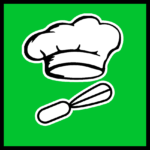3200 Cooking Green Belt

Professional Cooking 3200 – Chef de Partie
This level focuses on intermediate cooking techniques including poaching, deglazing, blanching, slow cooking, frying, and braising. These methods are discussed in the context of achieving desired textures and flavors, with a special emphasis on the intricate aspects of each technique.
3201 Glossary of Common Kitchen Terms
Navigating the kitchen successfully often means knowing the language used every day by chefs and cooking enthusiasts. This section provides a detailed glossary of some of the most common kitchen terms, which can help enhance your cooking skills and understanding of recipes and cooking shows.
3202 Mise en Place and Kitchen Organization
The mise en place and kitchen organization teaches essential techniques to make your kitchen work more efficient and organized. This module helps you optimize preparation processes, improve time management, and organize your workflow at a professional level. It emphasizes the importance of having all components in place for a successful kitchen.
3203 Reading and Executing Recipes
Reading and Executing Recipes section, essential skills for accurately reading and executing recipes. Covering all stages—from recipe analysis and time management to kitchen techniques and presentation—it offers practical guidance to ensure consistency and quality in a professional kitchen. With steps for deeply understanding and successfully applying recipes, this guide equips kitchen professionals with efficient and organized work methods.
3204 Quality Control in Culinary Operations
Quality control in culinary settings ensures that food products are safe, consistent, and of high quality. This section covers various practices from recipe standardization to proper storage techniques. Understanding and implementing these practices effectively can greatly enhance the safety and quality of food served.
3205 Advanced Cooking Techniques
The advanced cooking techniques module offers participants comprehensive training to master the art of culinary skills. This module aims to equip participants with the ability to apply innovative and sophisticated techniques in the kitchen while enhancing their creativity and precision.
3205.0101 Blanching
3205.0102 Deglazing
3205.0103 Frying
3205.0104 Poaching
3205.0105 Shocking
3205.0106 Slow Cooking
3206 Knife Skills Level 2
Building on basic knife skills, this section delves into more sophisticated cutting techniques and the maintenance of high-quality kitchen cutlery. Focus areas include julienne, brunoise, and other fine cuts essential for professional presentation.
3207 Sauce and Stock Level 1
An introduction to the fundamentals of making sauces and stocks, the backbone of many culinary dishes. This section covers basic recipes and techniques for creating rich, flavorful bases that can enhance any dish.
3208 Salad Greens and Micro-Greens
Salad greens and micro-greens are essential components of a healthy diet, offering a variety of flavors, textures, and nutrients. This section explores different types of salad greens, how to prepare salads and dressings, and delves into the world of micro-greens, discussing their nutritional benefits and culinary uses.
3209 Beef Preparation
Proper pre-cooking preparation of meat is essential for achieving the best results in terms of flavor, texture, and food safety.
3210 Cooking Temperatures and Resting for Beef
Cooking beef to the correct internal temperature ensures both culinary success and food safety.
3211 Beef Recipes and Plating
Understanding various cooking techniques is crucial for maximizing the flavor and texture of different cuts of beef.
3212 Lamb and Goat 1
Basics of cooking lamb and goat, exploring different cuts and cooking methods suitable for these meats, including grilling, stewing, and roasting.
3213 Poultry Preparation
This section covers advanced techniques for preparing poultry, including brining, roasting, and carving, with a focus on enhancing flavors and presentation in sophisticated dishes.
3214 Pork Level 1
An introductory guide to pork cuts and basic preparation methods, focusing on roasting, frying, and smoking to maximize flavor and tenderness.
3215 Seafood Level 2
Advanced techniques and insights into preparing seafood, covering a variety of species from fish to shellfish, focusing on methods that enhance freshness and flavor.
3216 Exploring Fresh Pasta
Diving into the world of fresh pasta opens up a realm of culinary creativity and texture that cannot be matched by its dried counterparts. This section provides a comprehensive guide to understanding and preparing various types of fresh pasta, focusing on the differences in flavor, texture, and sauce pairing.
3217 Baking and Pastry Level 1
An introduction to the art of baking and pastry, covering fundamental techniques for creating bread, pastries, and desserts, with a focus on ingredient selection, dough preparation, and baking processes.
3218 Plate Presentation and Culinary Photography
This section explores the artistry and techniques behind exceptional plate presentation and culinary photography. From advanced food styling methods to equipment choices and digital editing strategies, it provides insights into creating visually captivating images that highlight the textures, colors, and appeal of each dish. Perfect for anyone aiming to elevate their culinary presentation and photography skills, this guide offers professional tips and tools for impactful food imagery.
